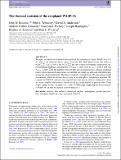Files in this item
The thermal emission of the exoplanet WASP-3b
Item metadata
| dc.contributor.author | Rostron, J.W. | |
| dc.contributor.author | Wheatley, P.J. | |
| dc.contributor.author | Anderson, D.R. | |
| dc.contributor.author | Cameron, A.C. | |
| dc.contributor.author | Fortney, J.J. | |
| dc.contributor.author | Harrington, J. | |
| dc.contributor.author | Knutson, H.A. | |
| dc.contributor.author | Pollacco, D.L. | |
| dc.date.accessioned | 2014-09-05T16:31:01Z | |
| dc.date.available | 2014-09-05T16:31:01Z | |
| dc.date.issued | 2014-07-11 | |
| dc.identifier | 146011060 | |
| dc.identifier | 5a57d803-e486-4f4c-8b33-ba72fa20ecea | |
| dc.identifier | 84903169482 | |
| dc.identifier | 000338764700064 | |
| dc.identifier.citation | Rostron , J W , Wheatley , P J , Anderson , D R , Cameron , A C , Fortney , J J , Harrington , J , Knutson , H A & Pollacco , D L 2014 , ' The thermal emission of the exoplanet WASP-3b ' , Monthly Notices of the Royal Astronomical Society , vol. 441 , no. 4 , pp. 3666-3678 . https://doi.org/10.1093/mnras/stu814 | en |
| dc.identifier.issn | 0035-8711 | |
| dc.identifier.other | ORCID: /0000-0002-8863-7828/work/58531325 | |
| dc.identifier.uri | https://hdl.handle.net/10023/5367 | |
| dc.description.abstract | We report the detection of thermal emission from the transiting hot Jupiter WASP-3b at 3.6, 4.5 and 8.0 μm using the Spitzer Space Telescope. We obtain planet-to-star flux ratios of 0.209+0.040-0.028 , 0.282 ± 0.012 and 0.328+0.086-0.055 per cent at these wavelengths, respectively, implying infrared brightness temperatures of T3.6μm = 2280+280-150 K, T4.5μm = 2400 ± 80K and T8.0μm = 2210+390-250 K. We find that WASP-3b falls into an emerging class of highly irradiated planets whose measured temperatures suggest that the planets are dark and redistribute heat around the planet inefficiently. The latter is similarly concluded from 1D atmospheric model comparisons, which also favour the presence of an atmospheric temperature inversion. We compare the WASP-3 system to the proposed inversion-activity relation, finding that it hints at a more complex relation than a simple cut-off in activity implied by previous data. Using eclipse timings we also constrain e cos ω to be -0.0006+0.0010-0.0006 , suggesting that the eccentricity of WASP-3b can only be large for a narrow range of ω. | |
| dc.format.extent | 13 | |
| dc.format.extent | 2135403 | |
| dc.language.iso | eng | |
| dc.relation.ispartof | Monthly Notices of the Royal Astronomical Society | en |
| dc.subject | Methods: data analysis | en |
| dc.subject | Planets and satellites: atmospheres | en |
| dc.subject | Planets and satellites: individual: WASP-3b | en |
| dc.subject | Stars: individual: WASP-3 | en |
| dc.subject | QB Astronomy | en |
| dc.subject | QC Physics | en |
| dc.subject.lcc | QB | en |
| dc.subject.lcc | QC | en |
| dc.title | The thermal emission of the exoplanet WASP-3b | en |
| dc.type | Journal article | en |
| dc.contributor.sponsor | Science & Technology Facilities Council | en |
| dc.contributor.sponsor | PPARC - Now STFC | en |
| dc.contributor.sponsor | Science & Technology Facilities Council | en |
| dc.contributor.sponsor | Science & Technology Facilities Council | en |
| dc.contributor.sponsor | Science & Technology Facilities Council | en |
| dc.contributor.institution | University of St Andrews. School of Physics and Astronomy | en |
| dc.identifier.doi | 10.1093/mnras/stu814 | |
| dc.description.status | Peer reviewed | en |
| dc.identifier.grantnumber | ST/I000666/1 | en |
| dc.identifier.grantnumber | PP/D000890/1 | en |
| dc.identifier.grantnumber | ST/J001651/1 | en |
| dc.identifier.grantnumber | ST/G001006/1 | en |
| dc.identifier.grantnumber | PP/F000065/1 | en |
This item appears in the following Collection(s)
Items in the St Andrews Research Repository are protected by copyright, with all rights reserved, unless otherwise indicated.

